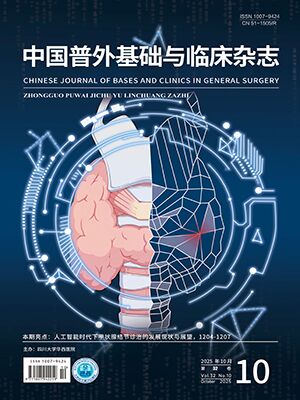| 1. |
孫可欣, 鄭榮壽, 張思維, 等. 2015 年中國分地區惡性腫瘤發病和死亡分析. 中國腫瘤, 2019, 28(1): 1-11.
|
| 2. |
Kulik L, Heimbach JK, Zaiem F, et al. Therapies for patients with hepatocellular carcinoma awaiting liver transplantation: a systematic review and meta-analysis. Hepatology, 2018, 67(1): 381-400.
|
| 3. |
Tsoulfas G. Current perspective in the management of hepatocellular carcinoma: time to get personal! J Invest Surg, 2020, [Online ahead of print].
|
| 4. |
中華人民共和國國家衛生健康委員會醫政醫管局. 原發性肝癌診療規范 (2017 年版). 中國實用外科雜志, 2017, 37(7): 705-720.
|
| 5. |
Zhang W, Wang X, Jiang R, et al. Effect of tumor size on cancer-specific survival in small hepatocellular carcinoma. Mayo Clin Proc, 2015, 90(9): 1187-1195.
|
| 6. |
盛若凡, 金開璞, 陳旭曉, 等. 巴塞羅那 0 期肝細胞癌患者術后肝內復發危險因素. 中華肝膽外科雜志, 2018, 24(12): 793-796.
|
| 7. |
趙暉, 陳駿, 嚴笑鵬, 等. 肝細胞癌患者微血管侵犯的組織學風險分級與預后的關系. 中華肝膽外科雜志, 2019, 25(6): 401-405.
|
| 8. |
施顯茂, 陳潔, 麥榮云, 等. 乙肝相關性巴塞羅那 A 期肝細胞癌術后早期復發轉移的危險因素分析. 中華普通外科雜志, 2019, 34(2): 97-99.
|
| 9. |
呂少誠, 潘冰, 李立新, 等. 原發性肝癌肝移植患者預后評價及相關影響因素分析. 中華肝膽外科雜志, 2019, 25(7): 493-496.
|
| 10. |
Sumie S, Nakashima O, Okuda K, et al. The significance of classifying microvascular invasion in patients with hepatocellular carcinoma. Ann Surg Oncol, 2014, 21(3): 1002-1009.
|
| 11. |
Erstad DJ, Tanabe KK. Prognostic and therapeutic implications of microvascular invasion in hepatocellular carcinoma. Ann Surg Oncol, 2019, 26(5): 1474-1493.
|
| 12. |
Chan SC, Fan ST, Chok KS, et al. Survival advantage of primary liver transplantation for hepatocellular carcinoma within theup-to-7 criteria with microvascular invasion. Hepatol Int, 2011, 6(3): 646-656.
|
| 13. |
中國抗癌協會肝癌專業委員會, 中華醫學會肝病學分會肝癌學組, 中國抗癌協會病理專業委員會, 等. 原發性肝癌規范化病理診斷指南 (2015 年版). 中華肝膽外科雜志, 2015, 21(3): 145-151.
|
| 14. |
Shindoh J, Kobayashi Y, Kawamura Y, et al. Microvascular invasion and a size cutoff value of 2 cm predict long-term oncological outcome in multiple hepatocellular carcinoma: reappraisal of the American Joint Committee on cancer staging system and validation using the Surveillance, Epidemiology, and End-Results Database. Liver Cancer, 2020, 9(2): 156-166.
|
| 15. |
Kobayashi Y, Kiya Y, Sugawara T, et al. Expanded Makuuchi’s criteria using estimated indocyanine green clearance rate of future liver remnant as a safety limit for maximum extent of liver resection. HPB (Oxford), 2019, 21(8): 990-997.
|
| 16. |
European Association for the Study of the Liver. Electronic address: easloffice@easloffice. eu. EASL Clinical Practice Guidelines: management of hepatocellular carcinoma. J Hepatol, 2018, 69(1): 182-236.
|
| 17. |
Shindoh J, Makuuchi M, Matsuyama Y, et al. Complete removal of the tumor-bearing portal territory decreases local tumor recurrence and improves disease-specific survival of patients with hepatocellular carcinoma. J Hepatol, 2016, 64(3): 594-600.
|
| 18. |
Famularo S, Piardi T, Molfino S, et al. Factors affecting local and intra hepatic distant recurrence after surgery for HCC: an alternative perspective on microvascular invasion and satellitosis–a Western European multicentre study. J Gastrointest Surg, 2020, [Online ahead of print].
|
| 19. |
Famularo S, Di Sandro S, Giani A, et al. Recurrence patterns after anatomic or parenchyma-sparing liver resection for hepatocarcinoma in a western population of cirrhotic patients. Ann Surg Oncol, 2018, 25(13): 3974-3981.
|
| 20. |
Li J, Han X, Yu X, et al. Clinical applications of liquid biopsy as prognostic and predictive biomarkers in hepatocellular carcinoma: circulating tumor cells and circulating tumor DNA. J Exp Clin Cancer Res, 2018, 37(1): 213.
|
| 21. |
Sun YF, Guo W, Xu Y, et al. Circulating tumor cells from different vascular sites exhibit spatial heterogeneity in epithelial and mesenchymal composition and distinct clinical significance in hepatocellular carcinoma. Clin Cancer Res, 2018, 24(3): 547-559.
|
| 22. |
Chen SL, Xiao H, Xie ZL, et al. The presence of microvascular invasion guides treatment strategy in recurrent HBV-related HCC. Eur Radiol, 2020, 30(6): 3473-3485.
|
| 23. |
Vivarelli M, Cucchetti A, La Barba G, et al. Liver transplantation for hepatocellular carcinoma under calcineurin inhibitors: reassessment of risk factors for tumor recurrence. Ann Surg, 2008, 248(5): 857-862.
|
| 24. |
Cholongitas E, Mamou C, Rodríguez-Castro KI, et al. Mammalian target of rapamycin inhibitors are associated with lower rates of hepatocellular carcinoma recurrence after liver transplantation: a systematic review. Transpl Int, 2014, 27(10): 1039-1049.
|
| 25. |
Chen W, Ma T, Zhang J, et al. A systematic review and meta-analysis of adjuvant transarterial chemoembolization after curative resection for patients with hepatocellular carcinoma. HPB (Oxford), 2020, 22(6): 795-808.
|
| 26. |
邱慧兵, 易鐵男. FOLFOX7 新輔助化療方案聯合肝移植術治療進展期肝癌的療效觀察. 河北醫藥, 2017, 39(7): 1020-1022.
|
| 27. |
周儉, 肖永勝, 樊嘉. 分子靶向藥物對肝癌復發轉移防治作用. 中國實用外科雜志, 2012, 32(10): 860-864.
|
| 28. |
高婧雅, 郭慶軍, 謝炎, 等. 雷帕霉素聯合索拉非尼在超米蘭標準肝移植肝細胞癌復發患者中的療效觀察. 中國普外基礎與臨床雜志, 2018, 25(9): 1039-1043.
|
| 29. |
毛廷輝, 吳剛. 復發性肝癌靶向治療及免疫治療. 中國實用外科雜志, 2019, 39(10): 1048-1051.
|
| 30. |
Tang J, Sui CJ, Wang DF, et al. Targeted sequencing reveals the mutational landscape responsible for sorafenib therapy in advanced hepatocellular carcinoma. Theranostics, 2020, 10(12): 5384-5397.
|




